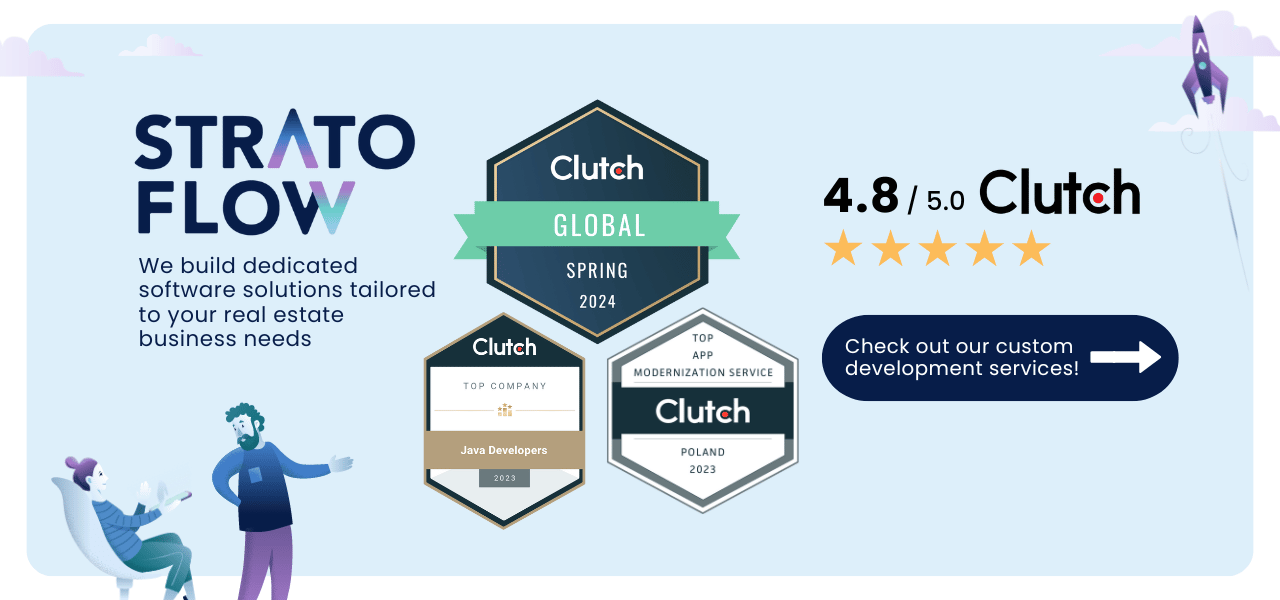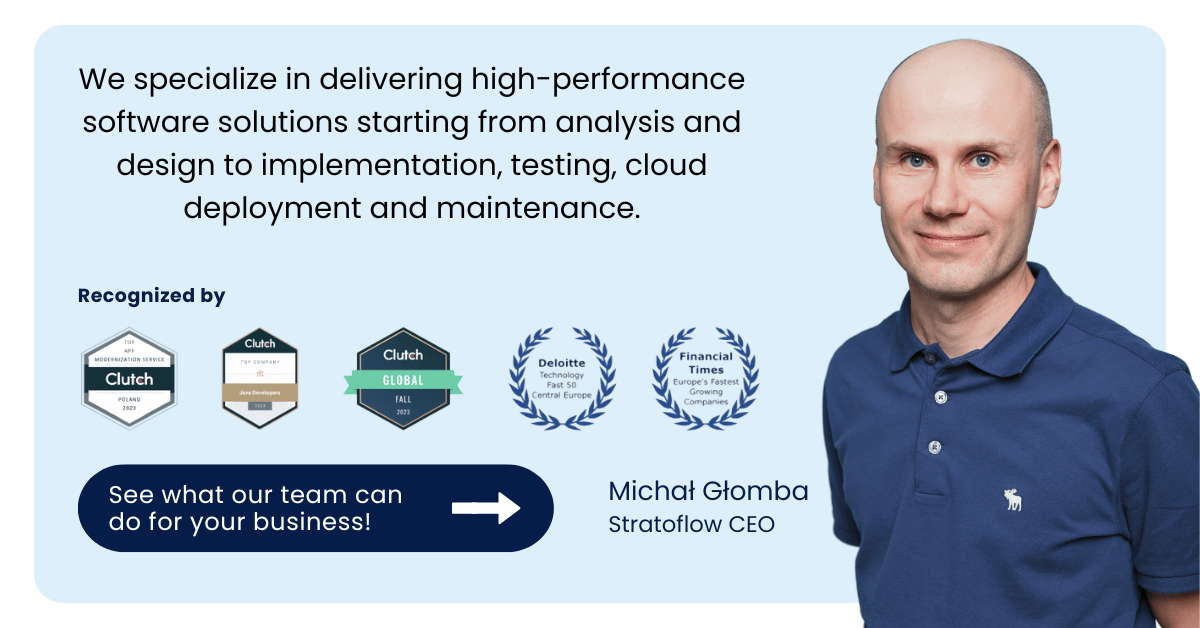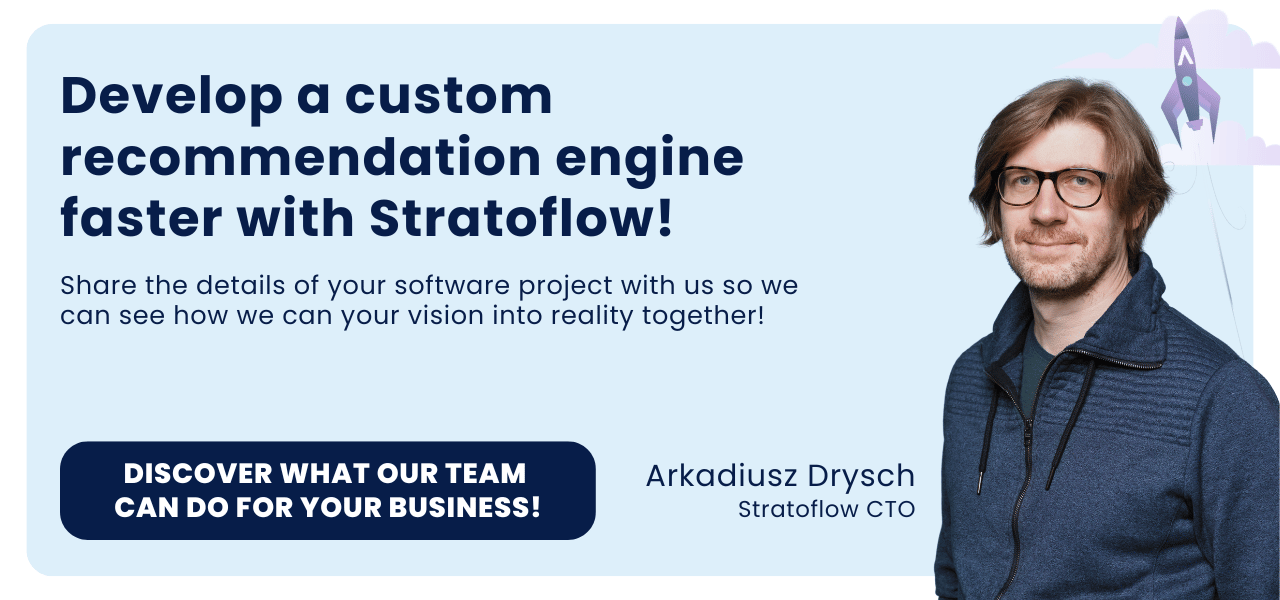
Netflix Algorithm: How Netflix Uses AI to Improve Personalization
Have you ever wondered how Netflix always seems to know exactly what you want to watch next?
At the heart of Netflix’s user experience is a sophisticated recommendation algorithm that tailors content to individual preferences, keeping viewers engaged and satisfied.
In this article we dive into the intricate workings of Netflix’s recommendation system, exploring how it personalizes suggestions using cutting-edge AI techniques, and seeing how other businesses can learn from Netflix example.
Contents
- What Is The Netflix Algorithm?
- Unlocking the Power of Netflix’s Recommendation Engine for Your Business
- How it All Started: Netflix Prize 2006
- How Does Netflix’s Recommendation System Work?
- What Types of Data Does Netflix Recommendation System Use?
- How does Netflix know our taste in movies so well and what we want to watch?
- Recommendation engine in other streaming services
What Is The Netflix Algorithm?
The statistics speak for themselves: despite fierce competition, Netflix maintains its strong position as one of the most popular streaming platforms.
In 2023, Netflix added approximately 8.9 million new subscribers, bringing its total to approximately 238.4 million subscribers worldwide.
With over 15,000 different movies and series in the Netflix catalog, it is almost impossible for users to find the movies they like and find interesting on their own.
This is where the personalized recommendation engine comes in.
Netflix uses a sophisticated system to predict and suggest content that users are most likely to enjoy. This algorithm plays a critical role in keeping users engaged and driving the success of the platform.
By tailoring content suggestions to each user’s unique tastes, the algorithm not only simplifies the decision-making process, but also ensures that users remain engaged and satisfied with the service.
Today, the recommendation algorithm is essential to Netflix’s business model.
According to Netflix, more than 80% of content viewed on the platform is discovered through personalized recommendations.
Moreover, the algorithm’s impact goes beyond simply entertaining users.
It also influences content production decisions. By analyzing viewing patterns and user preferences, Netflix gains valuable insight into the types of shows and movies that resonate with its audience.
The layout of the recommendations is not accidental
In 2024, Netflix’s recommendation engine is incredibly sophisticated.
From the user’s perspective, the first interaction with the recommendation system is on the Netflix home page, where movies are displayed in horizontal rows.
Each row contains movies and shows from different categories:
- Selected for you: A list of movies and series tailored to meet the user’s preferences based on their browsing history.
- Trending: A collection of the most popular content currently on the website. Probably movies and series that just has hit the streaming service and is stirring up a lot of media deicussion.
- Similar to: Content similar to a series or movie that the user has shown a clear preference for, based on their viewing time and frequency.
- News: Newly added, interesting content that the website wants to promote to a broader audience.
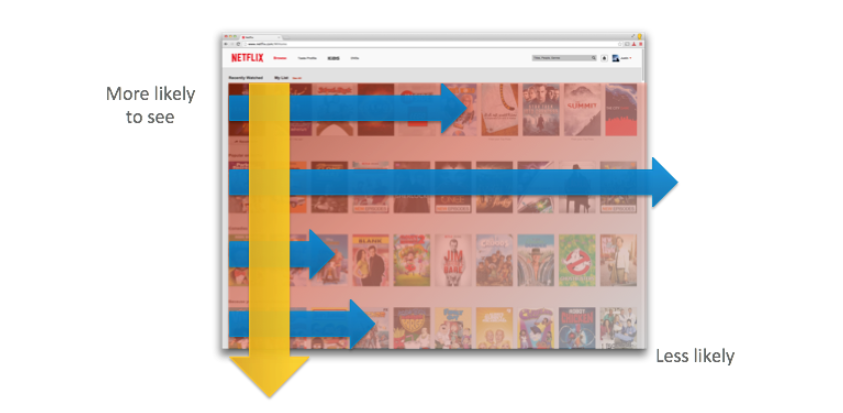
The arrangement of thumbnails in rows is no accident either.
Research has shown that users tend to focus on the top left of the screen, so the material most likely to be selected by users is placed to the left of the recommendation rows.
All of these models offer Netflix users a wide selection of movies and shows tailored to their interests, from which they are sure to find something of interest.
[Read also: Online Shopping Recommendations – How to Introduce Them in Your Business?]
Personalized recommendations: Key factor in business success in 2024
The numbers don’t lie.
By 2024, personalized recommendation engines will be a critical factor in the success of not only the Netflix platform, but the entire streaming industry.
The effectiveness of these algorithms in curating content tailored to individual tastes has a profound impact on user engagement, satisfaction, and ultimately, business success.
The vast majority of Netflix’s user base relies heavily on what the platform recommends to them. They rarely use the search box.
This personalized approach helps keep viewers engaged and reduces churn, which is critical to maintaining a stable subscriber base in a highly competitive market.
According to a McKinsey report, effective personalization based on user behavior can increase customer satisfaction by 20% and conversion rates by 10-15%.
Netflix has reported that the personalized engine is responsible for saving users a total of over 1,300 hours per day in search time.
This efficiency translates into more time spent watching content, which directly impacts the platform’s success metrics, such as average viewing time per user and overall engagement rates.
In addition to improving the user experience, the recommendation algorithm provides Netflix with invaluable data insights.
These insights are used to make strategic decisions about content creation and acquisition. For example, the success of Netflix originals such as “Stranger Things” and “The Witcher” can be partially attributed to data-driven decisions informed by the recommendation system.
As we can see, the power of personalized recommendation engines in the media industry is undeniable.
So is there a way to use it in your own business?
There is, in the form of custom recommendation engines.
Unlocking the Power of Netflix’s Recommendation Engine for Your Business
In the digital age, companies across industries are increasingly relying on personalized recommendation engines to improve the customer experience and drive growth.
These sophisticated systems, similar to those used by Netflix, leverage vast amounts of data to deliver personalized content and product suggestions to users.
Retailers use these systems to tailor their marketing efforts, resulting in a reported 15-30% increase in sales.
A study by Accenture found that 91% of consumers are more likely to shop with brands that provide relevant offers and recommendations.
Developing an effective recommendation engine is a complex task that requires a deep understanding of both data science and the specific market in which a business operates.
That’s where the help of custom software development companies like Stratoflow comes in.
These companies specialize in creating tailored solutions that meet the unique needs of their clients.

Stratoflow is a leading expert in the development of custom personalization engines, exemplified by our flagship product, Recostream.
Recostream is a state-of-the-art recommendation engine that delivers personalized product suggestions in real time.
This system can increase sales by 5-10% for e-commerce stores by analyzing user behavior and preferences to deliver highly relevant recommendations.
Recostream’s performance is unparalleled, generating recommendations in 20-30 milliseconds, ensuring a seamless and responsive user experience.
But our capabilities are not limited to the e-commerce industry.
Stratoflow specializes in developing custom recommendation engines for a variety of industries, ensuring tailored and effective solutions.
Here are just a few of the industries we serve:
- Media and Entertainment: Enhance user engagement by suggesting movies, TV shows, and music tailored to individual preferences, similar to Netflix and Spotify.
- Healthcare: Improve patient outcomes with personalized treatment plans by analyzing patient data to offer the best medical recommendations.
- Insurance: Offer customized insurance plans and financial advice, leveraging AI to assess risk and recommend suitable products.
- Finance: Speed up decision-making with AI-driven investment and financial advice tailored to individual financial goals.
- Food Delivery: Suggest meals and optimize delivery with AI, enhancing customer satisfaction through personalized menus and dynamic pricing.
- Real Estate: Improve user satisfaction by offering personalized property recommendations and market analysis tailored to individual preferences.
- Travel: Enhance the travel experience with personalized itineraries, flight and hotel recommendations, and dynamic pricing, increasing customer satisfaction and loyalty.
At Stratoflow, we understand the critical role that personalized recommendations play in modern business success.
Our expertise in building custom recommendation engines ensures that we can deliver solutions that are perfectly aligned with your unique business needs.
Whether you’re in e-commerce, healthcare, finance, or any other industry, our custom-built systems will improve customer engagement, increase sales, and improve overall user satisfaction.
How it All Started: Netflix Prize 2006
Netflix’s machine learning recommendation engine is the result of the work of hundreds of engineers over the past 20 years, and is a great example of the power of artificial intelligence and machine learning in action.
But how did it start?
In 2000, the company introduced the first groundbreaking personalized movie recommendations.
In 2006, the company launched the etflix Prize, a competition that offered $1 million to anyone who could improve the recommendation system by 10%.
The competition spurred significant advances in machine learning and predictive analytics, culminating in a more sophisticated algorithm that could better understand user preferences.
The system has gone through many iterations, and by 2024 it is a blend of all the most popular data analysis and filtering methods.
How Does Netflix’s Recommendation System Work?
Netflix’s current recommendation algorithm is a hybrid system that incorporates multiple models and techniques, blending collaborative filtering with content-based filtering and deep learning.
Collaborative Filtering Algorithms
Initially, Netflix relied on a collaborative filtering method based primarily on user ratings.
It studies the patterns of users with similar tastes or the same or similar queries to suggest new content. There are two primary forms: user-based and item-based collaborative filtering.
User-based focuses on finding users with similar viewing histories, while item-based looks at the similarities between content items themselves.
However, as Netflix’s library and user base grew, the need for a more nuanced and effective recommendation system became apparent.
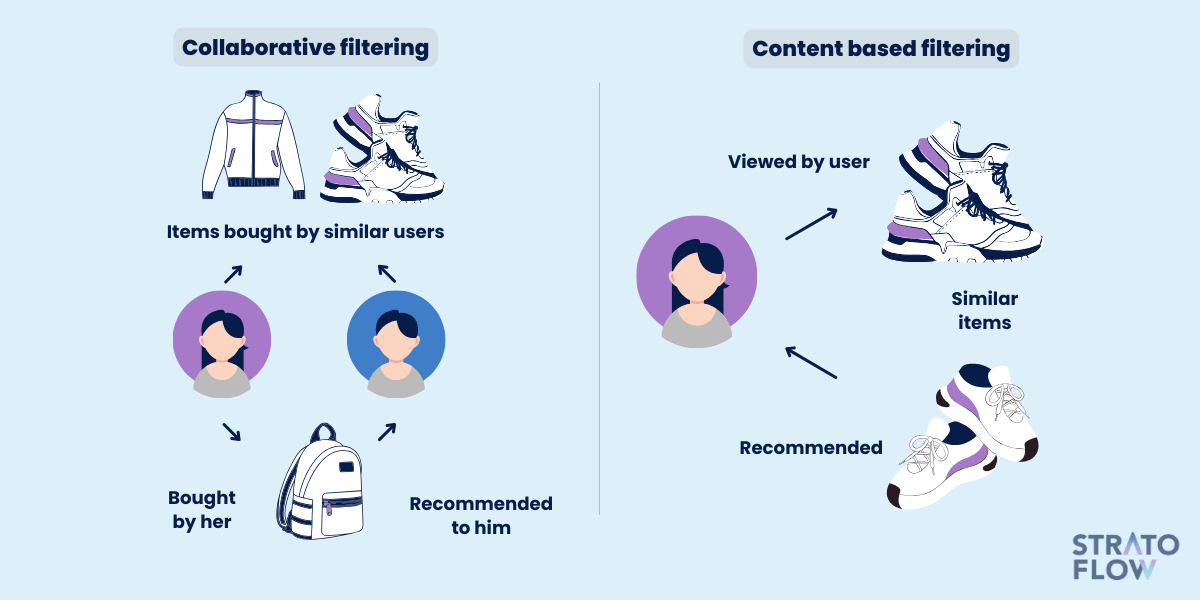
Content based filtering
Unlike collaborative filtering, which relies on user behavior, content-based filtering recommends content based on the attributes of the items themselves.
Content-based filtering works by examining the metadata associated with each piece of content.
This metadata includes a wide range of attributes such as genre, director, cast, release year, language, and even specific themes or keywords that describe the plot and setting.
For example, a movie might be tagged with attributes such as “action,” “superhero,” “Marvel,” “Robert Downey Jr.” and “2022.
To continually improve, the algorithm uses reinforcement learning techniques.
This means it adapts based on user feedback and learns from user interactions to refine future suggestions. For example, if a user frequently skips a recommended show, the algorithm will adjust accordingly.
The sheer variety of content on Netflix means that user preferences can vary widely. Content-based filtering allows the algorithm to cater to niche interests by focusing on the specific attributes of the content.
This is especially important for users with unique tastes that may not align with broader viewing trends.
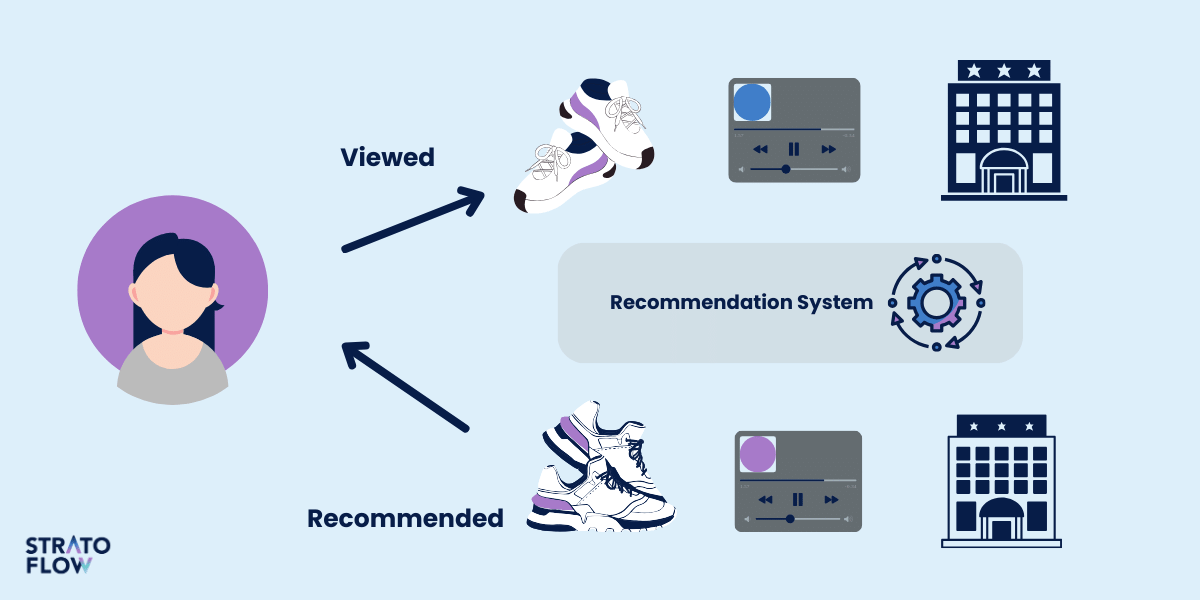
Netflix actually leverages a couple of subtypes of content based filtering in its system.
Here is a brief rundown of their characteristics:
Personalized Video Ranking (PVR)
This general algorithm sorts the catalog’s content by specific characteristics (e.g., sci-fi movies, romantic comedies) and matches it to a user’s personal preferences and tastes based on their viewing history.
Top-N Ranking
Similar to the PVR ranking, this algorithm focuses only on the top rankings of individual users to determine the most popular materials in a given category.
Ranking of Interesting Content for Further Viewing
This algorithm identifies content that a user has started but not finished watching. It calculates the likelihood that the user will want to return to that content by analyzing available data, including elapsed time since viewing, drop-off point, device used, etc.
Popular Movies Ranking
The algorithm analyzes the types of content that are currently popular. It takes into account various time trends and other information that may indicate that certain content is being selected more frequently. Key predictors in this ranking include
- Important world events: For example, the coronavirus pandemic contributed to the record popularity of the movie “Contagion”.
- Holidays and other occasions: For example, during Valentine’s Day in February, romantic comedies are very popular.
[Read also: Complementary Products: A Way to Increase Your Online Store Sales]
What Types of Data Does Netflix Recommendation System Use?
Data is the lifeblood of Netflix’s recommendation algorithm.
The platform collects a myriad of data points, such as the time of day users watch content, the devices they use, their geographic location, and even how long they hover over a title before selecting it.
As the user continues to use the service, the data is collected and processed in real time to provide dynamic and personalized recommendations.
Key types of data collected include
- User interactions with the website: Browsing history and ratings issued.
- Correlation data: Relationships and similarities between the tastes and preferences of individual user groups.
- Information about the content in the Netflix library: Genre, length, language, actors, etc.
Furthermore, Netflix uses additional information to better personalize the user experience:
- Time of day: When individual users use the website.
- Type of device: On which users view the content.
- Average viewing length: How long users typically watch content.
Pushing Recommendations Further: Recommendations Based on Movie Covers
Netflix’s commitment to personalization extends beyond content recommendations to the presentation of content itself.
One of the platform’s innovative approaches is to leverage and customize thumbnails – the images users see that represent each title on the interface.
Research shows that if a user on an entertainment platform does not find something interesting within 90 seconds, they are likely to lose interest and look for something else to do.
With such a short time to capture interest, images are the most effective way to get users’ attention as quickly as possible.
Netflix’s new algorithm, recently added to its recommendation engine, provides subscribers with unique thumbnails of movies and shows tailored to their tastes.
Netflix creates multiple thumbnail versions for each show or movie and uses A/B testing techniques to determine the effectiveness of different thumbnails for the same piece of content.
By showing different thumbnails to different groups of users and comparing engagement rates, Netflix can determine which images are most likely to capture attention.
Based on the insights gained from user interactions, Netflix dynamically adjusts thumbnails to better suit the tastes of individual users.

In the example above, we can see how a Pulp Fiction movie can be offered to Netflix users with different thumbnails depending on whether the person has a lot of movies with Uma Thurman or John Travolta in their browsing history.
This makes it much more likely that a given user will pay attention to this movie.
This solution also applies to movie trailers and series.
A good example of this type of personalization can be the popular Netflix series House of Cards.
If a user prefers movies and series with strong female characters, they will be shown a trailer featuring mostly Robin Wright, who plays Claire Underwood.
In turn, those who like political dramas in general will see the main trailer with Kevin Spacey in the lead role.
Statistics show that Netflix’s algorithm guarantees that even 90% of users will like the trailer and will be interested in watching the first episode.
[Read also: How to Introduce Product Recommendations in Your Business]
How does Netflix know our taste in movies so well and what we want to watch?
The answer can be quite simple: AI.
But in reality, it’s more complicated than that.
Netflix uses artificial intelligence and machine learning algorithms to generate content recommendations.
The problem, however, is recommending movies and shows to users about whom the system has little information.
To solve this, when users start their Netflix account, the platform asks them to select some of their favorite shows and movies, and this data serves as a starting point for further optimization.
Later, as users continue to watch, over time the recommendation engine begins to better understand their preferences and tastes, and adjusts the list of featured content based on the data collected.
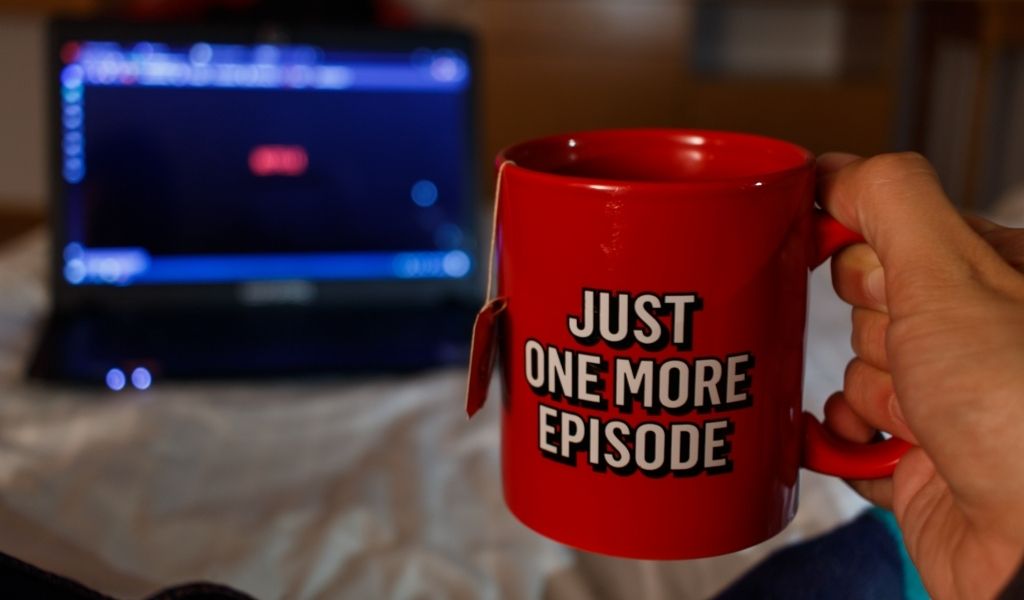
Does all of this pay off and does Netflix’s recommendation system actually benefit the company?
Of course.
As we’ve already mentioned it is estimated that over 80 percent of the TV shows people watch on Netflix are discovered through the platform’s recommendation system.
What’s more, according to the latest data, Netflix’s recommendation engine saves the company over $ 1 billion annually.
Many streaming platforms such as Hulu and Disney + have their content-based recommendation systems, but it is the Netflix engine that turns out to be the most effective.
Statistics show that 47% of US residents prefer to use Netflix.
By comparison, Amazon Prime ranks second with just 14%, while Hulu and Disney + showed 13.6% and 13% respectively.
Recommendation engine in other streaming services
After exploring the sophisticated AI-driven recommendation system of Netflix, it is clear that personalized content delivery is a cornerstone of modern digital media platforms.
Just as Netflix uses advanced algorithms to tailor its content to individual users, other platforms like Spotify, TikTok, and YouTube have developed their own unique recommendation engines to enhance user experience and engagement.
Spotify’s Recommendation Engine
Spotify is a digital music, podcast and video service that provides you with access to millions of songs and other content from creators around the world.
The Spotify engine, like Netflix, combines elements of various strategies and methods of data filtering used by models of various types to create one effective and comprehensive solution..
Spotify’s recommendation engine is most evident in features like “Discover Weekly” and “Release Radar.”
The “Discover Weekly” playlist generates a personalized list of tracks each week based on the user’s listening history and preferences, introducing them to new artists and songs. “Release Radar” similarly updates users with new releases tailored to their tastes.
As it turns out, these playlists has been surprisingly succesful.
Within the five years since its launch, listeners have listened to over 2.3 billion hours of music offered to them via personalized playlists between July 2015 and June 25, 2020 often showing them more niche musicians that they would otherwise be unlikely to discover.
TikTok’s Recommendation Engine
TikTok, the popular short-form video platform, owes much of its rapid growth and high user engagement to its highly addictive recommendation engine.
Central to TikTok’s user experience is the “For You Page” (FYP), a personalized feed of videos designed to surface content that users are likely to find interesting. TikTok’s algorithm collects and analyzes extensive user interaction data, including likes, comments, shares, watch time, and replays.
One of TikTok’s unique features is its ability to adapt in real-time, quickly responding to changes in user behavior and preferences, continuously updating the FYP to reflect the latest trends and interests.
This approach ensures high levels of engagement, with users opening the app an average of 20 times per day and spending around 90 minutes on it daily.
Moreover, 92% of TikTok users take action after watching a video, such as sharing or commenting, highlighting the platform’s strong engagement metrics
Youtube’s Recommendation Engine
YouTube, the world’s largest video-sharing platform, employs a complex AI recommendation engine to personalize content for its vast user base.
The system consists of two neural networks responsible for various types of data filtering.
Similarly to Netflix and Spotify, the former filters user data to look for links between their tastes, while the latter sorts videos based on their characteristics and data, taking into account their ratings, number of views, comments, description and tags.
YouTube’s recommendation system has undergone many modifications throughout the history of the website’s operation.
From 2005 to 2011, the main ranking aspect was simply the total number of clicks and views.
As of 2012, total watch time has been the most influential factor in video recommendations.
In turn, since 2015, this audience engagement has been the major factor taken into account by YouTube’s algorithms.
In recent years content moderation has also been a major factor influencing the recommendation algorithms often censoring content related to violence and controversial topics.
Despite that, the effectiveness of YouTube’s recommendation engine leaves no room for doubt.
According to experts, most of the video traffic on the platform is generated by the recommendation system and not by organic search results.
Related Posts
- Inside the Netflix Algorithm: AI Personalizing User Experience
- Music Recommendation System: How Do Streaming Platforms Use AI?
- How to Use Ecommerce Recommendations to Drive Sales?
- Complementary Products: A Way to Increase Your Online Store Sales
- Custom Recommendation Engines: What They Are and How to Use Them
Thank you for taking the time to read our blog post!


